Satellite-Observed Transport of Dust to the East China Sea and the North Pacific Subtropical Gyre: Contribution of Dust to the Increase in Chlorophyll during Spring 2010
Abstract
:1. Introduction
2. Data and Methods
2.1. Vertical Profile and Column Properties of Satellite-Observed Aerosols
2.2. Backward Trajectory Model and Meteorological Data
2.3. Dust Transport Model
2.4. Satellite-Observed Ocean Color and Climatological Ocean Nutrients
3. Environmental Background in the ECS and NPSG
4. Results and Discussion
4.1. Satellite Observations of the Long-Range Transport of Dust to the ECS and the NPSG in Spring 2010
4.2. Desert Source of Dust Storms Affecting the ECS and the NPSG
4.3. Spring Bloom in the ECS and Summer Bloom in the NPSG
4.4. Simulated Dust Deposition, Estimations of Nutrients and Their Contribution to Biological Productivity
5. Conclusions
Acknowledgments
Author Contributions
Conflicts of Interest
References
- Zhang, X.Y.; Gong, S.-L.; Zhao, T.-L.; Arimoto, R. Sources of asian dust and role of climate change versus desertification in Asian dust emission. Geophys. Res. Lett. 2003, 30, 2272. [Google Scholar] [CrossRef]
- China Meteorological Administration (CMA). Grade of Sand and Dust Storm Weather, National Standard of the People’s Republic of China; gb/t 20480-2006; China Meteorological Administration (CMA), Standardization Administration of China (SAC): Beijing, China, 2006. (In Chinese)
- Li, J.; Han, Z.; Zhang, R. Model study of atmospheric particulates during dust storm period in March 2010 over east asia. Atmos. Environ. 2011, 45, 3954–3964. [Google Scholar] [CrossRef]
- Li, J.; Wang, Z.; Zhuang, G.; Luo, G.; Sun, Y.; Wang, Q. Mixing of asian mineral dust with anthropogenic pollutants over east Asia: A model case study of a super-duststorm in March 2010. Atmos. Chem. Phys. 2012, 12, 7591–7607. [Google Scholar] [CrossRef]
- Wang, S.-H.; Hsu, N.C.; Tsay, S.-C.; Lin, N.-H.; Sayer, A.M.; Huang, S.-J.; Lau, W.K.M. Can asian dust trigger phytoplankton blooms in the oligotrophic northern South China Sea? Geophys. Res. Lett. 2012, 39, L05811. [Google Scholar] [CrossRef]
- Tan, S.-C.; Wang, H. The transport and deposition of dust and its impact on phytoplankton growth in the Yellow Sea. Atmos. Environ. 2014, 99, 491–499. [Google Scholar] [CrossRef]
- Martin, J.H.; Fitzwater, S.E. Iron deficiency limits phytoplankton growth in the North-East Pacific Subarctic. Nature 1988, 331, 341–343. [Google Scholar] [CrossRef]
- Behrenfeld, M.J.; Bale, A.J.; Kolber, Z.S.; Aiken, J.; Falkowski, P.G. Confirmation of iron limitation of phytoplankton photosynthesis in the equatorial Pacific Ocean. Nature 1996, 383, 508–511. [Google Scholar] [CrossRef]
- Boyd, P.W. Ironing out algal issues in the Southern Ocean. Science 2004, 304, 396–397. [Google Scholar] [CrossRef] [PubMed]
- Jickells, T.D.; An, Z.S.; Andersen, K.K.; Baker, A.R.; Bergametti, G.; Brooks, N.; Cao, J.J.; Boyd, P.W.; Duce, R.A.; Hunter, K.A.; et al. Global iron connections between desert dust, ocean biogeochemistry, and climate. Science 2005, 308, 67–71. [Google Scholar] [CrossRef] [PubMed]
- Yuan, W.; Zhang, J. High correlations between asian dust events and biological productivity in the Western North Pacific. Geophys. Res. Lett. 2006, 33, L07603. [Google Scholar] [CrossRef]
- Jo, C.-O.; Lee, J.-Y.; Park, K.-A.; Kim, Y.-H.; Kim, K.-R. Asian dust initiated early spring bloom in the Northern East/Japan Sea. Geophys. Res. Lett. 2007, 34, L05602. [Google Scholar] [CrossRef]
- Duce, R.A.; LaRoche, J.; Altieri, K.; Arrigo, K.R.; Baker, A.R.; Capone, D.G.; Cornell, S.; Dentener, F.; Galloway, J.; Ganeshram, R.S.; et al. Impacts of atmospheric anthropogenic nitrogen on the open ocean. Science 2008, 320, 893–897. [Google Scholar] [CrossRef] [PubMed]
- Gabric, A.J.; Cropp, R.A.; McTainsh, G.H.; Johnston, B.M.; Butler, H.; Tilbrook, B.; Keywood, M. Australian dust storms in 2002–2003 and their impact on Southern Ocean biogeochemistry. Glob. Biogeochem. Cycles 2010, 24, GB2005. [Google Scholar] [CrossRef]
- Calil, P.H.R.; Doney, S.C.; Yumimoto, K.; Eguchi, K.; Takemura, T. Episodic upwelling and dust deposition as bloom triggers in low-nutrient, low-chlorophyll regions. J. Geophys. Res. 2011, 116, C06030. [Google Scholar] [CrossRef]
- Shi, J.-H.; Gao, H.-W.; Zhang, J.; Tan, S.-C.; Ren, J.-L.; Liu, C.-G.; Liu, Y.; Yao, X. Examination of causative link between a spring bloom and dry/wet deposition of Asian dust in the Yellow Sea, China. J. Geophys. Res. 2012, 117, D17304. [Google Scholar] [CrossRef]
- Furutani, H.; Meguro, A.; Iguchi, H.; Uematsu, M. Geographical distribution and sources of phosphorus in atmospheric aerosol over the North Pacific Ocean. Geophys. Res. Lett. 2010, 37, L03805. [Google Scholar] [CrossRef]
- Kim, T.-W.; Lee, K.; Najjar, R.G.; Jeong, H.-D.; Jeong, H.J. Increasing N abundance in the Northwestern Pacific Ocean due to atmospheric nitrogen deposition. Science 2011, 334, 505–509. [Google Scholar] [CrossRef] [PubMed]
- Shi, J.-H.; Zhang, J.; Gao, H.-W.; Tan, S.-C.; Yao, X.-H.; Ren, J.-L. Concentration, solubility and deposition flux of atmospheric particulate nutrients over the Yellow Sea. Deep Sea Res. Part II Top. Stud. Oceanogr. 2013, 97, 43–50. [Google Scholar] [CrossRef]
- Bishop, J.K.B.; Davis, R.E.; Sherman, J.T. Robotic observations of dust storm enhancement of carbon biomass in the North Pacific. Science 2002, 298, 817–821. [Google Scholar] [CrossRef] [PubMed]
- Han, Y.; Zhao, T.; Song, L.; Fang, X.; Yin, Y.; Deng, Z.; Wang, S.; Fan, S. A linkage between Asian dust, dissolved iron and marine export production in the deep ocean. Atmos. Environ. 2011, 45, 4291–4298. [Google Scholar] [CrossRef]
- Tan, S.-C.; Yao, X.; Gao, H.-W.; Shi, G.-Y.; Yue, X. Variability in the correlation between Asian dust storms and chlorophyll a concentration from the north to equatorial Pacific. PLoS ONE 2013, 8, e57656. [Google Scholar] [CrossRef] [PubMed]
- Boyd, P.W.; Mackie, D.S.; Hunter, K.A. Aerosol iron deposition to the surface ocean—Modes of iron supply and biological responses. Mar. Chem. 2010, 120, 128–143. [Google Scholar] [CrossRef]
- China Meteorological Administration (CMA). Sand Dust Weather Almanac; China Meteorological Administration (CMA), China Meteorological Press: Beijing, China, 2010. (In Chinese)
- Lin, C.Y.; Sheng, Y.F.; Chen, W.N.; Wang, Z.; Kuo, C.H.; Chen, W.C.; Yang, T. The impact of channel effect on Asian dust transport dynamics: A case in Southeastern Asia. Atmos. Chem. Phys. 2012, 12, 271–285. [Google Scholar] [CrossRef]
- Winker, D.M.; Vaughan, M.A.; Omar, A.; Hu, Y.; Powell, K.A.; Liu, Z.; Hunt, W.H.; Young, S.A. Overview of the calipso mission and caliop data processing algorithms. J. Atmos. Ocean. Technol. 2009, 26, 2310–2323. [Google Scholar] [CrossRef]
- Amiridis, V.; Wandinger, U.; Marinou, E.; Giannakaki, E.; Tsekeri, A.; Basart, S.; Kazadzis, S.; Gkikas, A.; Taylor, M.; Baldasano, J.; et al. Optimizing Calipso Saharan dust retrievals. Atmos. Chem. Phys. 2013, 13, 12089–12106. [Google Scholar] [CrossRef] [Green Version]
- Papagiannopoulos, N.; Mona, L.; Alados-Arboledas, L.; Amiridis, V.; Baars, H.; Binietoglou, I.; Bortoli, D.; D’Amico, G.; Giunta, A.; Guerrero-Rascado, J.L.; et al. Calipso climatological products: Evaluation and suggestions from earlinet. Atmos. Chem. Phys. 2016, 16, 2341–2357. [Google Scholar] [CrossRef]
- Murayama, T.; Müller, D.; Wada, K.; Shimizu, A.; Sekiguchi, M.; Tsukamoto, T. Characterization of Asian dust and siberian smoke with multi-wavelength raman Lidar over Tokyo, Japan in spring 2003. Geophys. Res. Lett. 2004, 31, L23103. [Google Scholar] [CrossRef]
- Liu, Z.; Sugimoto, N.; Murayama, T. Extinction-to-backscatter ratio of asian dust observed with high-spectral-resolution Lidar and raman Lidar. Appl. Opt. 2002, 41, 2760–2767. [Google Scholar] [CrossRef] [PubMed]
- Uno, I.; Yumimoto, K.; Shimizu, A.; Hara, Y.; Sugimoto, N.; Wang, Z.; Liu, Z.; Winker, D.M. 3D structure of Asian dust transport revealed by CALIPSO Lidar and a 4DVAR dust model. Geophys. Res. Lett. 2008, 35, L06803. [Google Scholar] [CrossRef]
- Torres, O.; Tanskanen, A.; Veihelmann, B.; Ahn, C.; Braak, R.; Bhartia, P.K.; Veefkind, P.; Levelt, P. Aerosols and surface UV products from ozone monitoring instrument observations: An overview. J. Geophys. Res. 2007, 112, D24S47. [Google Scholar] [CrossRef]
- Prospero, J.M.; Ginoux, P.; Torres, O.; Nicholson, S.E.; Gill, T.E. Environmental characterization of global sources of atmospheric soil dust identified with the NIMBUS-7 total ozone mapping spectrometer (TOMS) absorbing aerosol product. Rev. Geophys. 2002, 40, 1002. [Google Scholar] [CrossRef]
- Draxler, R.R.; Rolph, G.D. Hysplit (Hybrid Single-Particle Lagrangian Integrated Trajectory) Model Access via NOAA Arl Ready Website; NOAA Air Resources Laboratory: Silver Spring, MD, USA, 2010.
- Grell, G.A.; Dudhia, J.; Stauffer, D.R. A Description of the Fifth-Generation Penn State/NCAR Mesoscale Model (MM5); NCAR Technical Note, NCAR/TN-398+STR; The National Center for Atmospheric Research (NCAR): Boulder, CO, USA, 1994. [Google Scholar]
- Han, Z. A regional air quality model: Evaluation and simulation of O3 and relevant gaseous species in East Asia during spring 2001. Environ. Model. Softw. 2007, 22, 1328–1336. [Google Scholar] [CrossRef]
- Han, Z.; Xie, Z.; Wang, G.; Zhang, R.; Tao, J. Modeling organic aerosols over east china using a volatility basis-set approach with aging mechanism in a regional air quality model. Atmos. Environ. 2016, 124 Pt B, 186–198. [Google Scholar] [CrossRef]
- Huang, M.; Wang, Z.; He, D.; Xu, H.; Zhou, L. Modeling studies on sulfur deposition and transport in East Asia. Water Air Soil Pollut. 1995, 85, 1921–1926. [Google Scholar]
- Gong, G.-C.; Wen, Y.-H.; Wang, B.-W.; Liu, G.-J. Seasonal variation of chlorophyll a concentration, primary production and environmental conditions in the subtropical East China Sea. Deep Sea Res. Part II Top. Stud. Oceanogr. 2003, 50, 1219–1236. [Google Scholar] [CrossRef]
- Ning, X.; Liu, Z.; Cai, Y.; Fang, M.; Chai, F. Physicobiological oceanographic remote sensing of the East China Sea: Satellite and in situ observations. J. Geophys. Res. 1998, 103, 21623–21635. [Google Scholar] [CrossRef]
- Li, G.-X.; Han, X.-B.; Yue, S.-H.; Wen, G.-Y.; Yang, R.-M.; Kusky, T.M. Monthly variations of water masses in the East China Seas. Cont. Shelf Res. 2006, 26, 1954–1970. [Google Scholar] [CrossRef]
- Singh, R.P.; Prasad, A.K.; Kayetha, V.K.; Kafatos, M. Enhancement of oceanic parameters associated with dust storms using satellite data. J. Geophys. Res. 2008, 113, C11008. [Google Scholar] [CrossRef]
- Wang, B.-D.; Wang, X.-L.; Zhan, R. Nutrient conditions in the yellow sea and the east china sea. Estuar. Coast. Shelf Sci. 2003, 58, 127–136. [Google Scholar] [CrossRef]
- Chen, C.-T.A. Distributions of nutrients in the East China Sea and the South China Sea connection. J. Oceanogr. 2008, 64, 737–751. [Google Scholar] [CrossRef]
- Zhang, Y.; Yu, Q.; Ma, W.; Chen, L. Atmospheric deposition of inorganic nitrogen to the Eastern China Seas and its implications to marine biogeochemistry. J. Geophys. Res. 2010, 115, D00K10. [Google Scholar] [CrossRef]
- Karl, D.M.; Letelier, R.M. Nitrogen fixation-enhanced carbon sequestration in low nitrate, low chlorophyll seascapes. Mar. Ecol. Prog. Ser. 2008, 364, 257–268. [Google Scholar] [CrossRef]
- Wilson, C. Late summer chlorophyll blooms in the oligotrophic North Pacific Subtropical Gyre. Geophys. Res. Lett. 2003, 30, 1942. [Google Scholar] [CrossRef]
- Wilson, C.; Villareal, T.A.; Maximenko, N.; Bograd, S.J.; Montoya, J.P.; Schoenbaechler, C.A. Biological and physical forcings of late summer chlorophyll blooms at 30° N in the oligotrophic Pacific. J. Mar. Syst. 2008, 69, 164–176. [Google Scholar] [CrossRef]
- Dore, J.E.; Letelier, R.M.; Church, M.J.; Lukas, R.; Karl, D.M. Summer phytoplankton blooms in the oligotrophic North Pacific Subtropical Gyre: Historical perspective and recent observations. Prog. Oceanogr. 2008, 76, 2–38. [Google Scholar] [CrossRef]
- Qian, L.; Yang, Y.-L.; Wang, R.-Z. Analysis on black storm cause in Hexi Corridor on 24 April 2010. Plateau Meteorol. 2011, 30, 1653–1660. (In Chinese) [Google Scholar]
- Iwasaka, Y.; Shibata, T.; Nagatani, T.; Shi, G.Y.; Kim, Y.S.; Matsuki, A.; Trochkine, D.; Zhang, D.; Yamada, M.; Nagatani, M.; et al. Large depolarization ratio of free tropospheric aerosols over the Taklamakan Desert revealed by Lidar measurements: Possible diffusion and transport of dust particles. J. Geophys. Res. 2003, 108, 8652. [Google Scholar] [CrossRef]
- Sakai, T.; Nagai, T.; Nakazato, M.; Matsumura, T. Raman Lidar measurement of water vapor and ice clouds associated with Asian dust layer over Tsukuba, Japan. Geophys. Res. Lett. 2004, 31, L06128. [Google Scholar] [CrossRef]
- Mikami, M.; Shi, G.Y.; Uno, I.; Yabuki, S.; Iwasaka, Y.; Yasui, M.; Aoki, T.; Tanaka, T.Y.; Kurosaki, Y.; Masuda, K.; et al. Aeolian dust experiment on climate impact: An overview of Japan-China joint project adec. Glob. Planet. Chang. 2006, 52, 142–172. [Google Scholar] [CrossRef]
- Pappalardo, G.; Mona, L.; D’Amico, G.; Wandinger, U.; Adam, M.; Amodeo, A.; Ansmann, A.; Apituley, A.; Alados Arboledas, L.; Balis, D.; et al. Four-dimensional distribution of the 2010 Eyjafjallajökull volcanic cloud over Europe observed by EARLINET. Atmos. Chem. Phys. 2013, 13, 4429–4450. [Google Scholar] [CrossRef] [Green Version]
- Zhao, T.L.; Gong, S.L.; Zhang, X.Y.; Blanchet, J.-P.; McKendry, I.G.; Zhou, Z.J. A simulated climatology of Asian dust aerosol and its trans-Pacific transport. Part I: Mean climate and validation. J. Clim. 2006, 19, 88–103. [Google Scholar] [CrossRef]
- Iwasaka, Y.; Shi, G.Y.; Yamada, M.; Matsuki, A.; Trochkine, D.; Kim, Y.S.; Zhang, D.; Nagatani, T.; Shibata, T.; Nagatani, M.; et al. Importance of dust particles in the free troposphere over the Taklamakan Desert: Electron microscopic experiments of particles collected with a balloonborne particle impactor at Dunhuang, China. J. Geophys. Res. 2003, 108, 8644. [Google Scholar] [CrossRef]
- Uno, I.; Satake, S.; Carmichael, G.R.; Tang, Y.; Wang, Z.; Takemura, T.; Sugimoto, N.; Shimizu, A.; Murayama, T.; Cahill, T.A.; et al. Numerical study of Asian dust transport during the springtime of 2001 simulated with the Chemical Weather Forecasting System (CFORS) model. J. Geophys. Res. 2004, 109, D19S24. [Google Scholar] [CrossRef]
- Tan, S.-C.; Shi, G.-Y.; Shi, J.-H.; Gao, H.-W.; Yao, X. Correlation of Asian dust with chlorophyll and primary productivity in the Coastal Seas of China during the period from 1998 to 2008. J. Geophys. Res. 2011, 116, G02029. [Google Scholar] [CrossRef]
- Brody, S.R.; Lozier, M.S.; Dunne, J.P. A comparison of methods to determine phytoplankton bloom initiation. J. Geophys. Res. 2013, 118, 2345–2357. [Google Scholar] [CrossRef]
- Hsu, S.-C.; Tsai, F.; Lin, F.-J.; Chen, W.-N.; Shiah, F.-K.; Huang, J.-C.; Chan, C.-Y.; Chen, C.-C.; Liu, T.-H.; Chen, H.-Y.; et al. A super Asian dust storm over the East and South China Seas: Disproportionate dust deposition. J. Geophys. Res. 2013, 118, 7169–7181. [Google Scholar] [CrossRef]
- Zhuang, G.-S.; Guo, J.; Yuan, H.; Zhang, X. Coupling and feedback between iron and sulphur in air-sea exchange. Chin. Sci. Bull. 2003, 48, 1080–1086. [Google Scholar] [CrossRef]
- Hsu, S.-C.; Wong, G.T.F.; Gong, G.-C.; Shiah, F.-K.; Huang, Y.-T.; Kao, S.-J.; Tsai, F.; Candice Lung, S.-C.; Lin, F.-J.; Lin, I.I.; et al. Sources, solubility, and dry deposition of aerosol trace elements over the East China Sea. Mar. Chem. 2010, 120, 116–127. [Google Scholar] [CrossRef]
- Baker, A.R.; Jickells, T.D.; Witt, M.; Linge, K.L. Trends in the solubility of iron, aluminium, manganese and phosphorus in aerosol collected over the Atlantic Ocean. Mar. Chem. 2006, 98, 43–58. [Google Scholar] [CrossRef]
- Schmidt, M.A.; Hutchins, D.A. Size-fractionated biological iron and carbon uptake along a coastal to offshore transect in the NE Pacific. Deep Sea Res. Part II Top. Stud. Oceanogr. 1999, 46, 2487–2503. [Google Scholar] [CrossRef]
- Fasham, M.J.R.; Ducklow, H.W.; McKelvie, S.M. A nitrogen-based model of plankton dynamics in the oceanic mixed layer. J. Mar. Res. 1990, 48, 591–639. [Google Scholar] [CrossRef]
- Chen, L.Y.-L.; Chen, H.-Y. Nitrate-based new production and its relationship to primary production and chemical hydrography in spring and fall in the East China Sea. Deep Sea Res. Part II Top. Stud. Oceanogr. 2003, 50, 1249–1264. [Google Scholar] [CrossRef]
- Chen, H.-Y.; Chen, L.-D. Importance of anthropogenic inputs and continental-derived dust for the distribution and flux of water-soluble nitrogen and phosphorus species in aerosol within the atmosphere over the East China Sea. J. Geophys. Res. 2008, 113, D11303. [Google Scholar] [CrossRef]
- Illingworth, A.J.; Barker, H.W.; Beljaars, A.; Ceccaldi, M.; Chepfer, H.; Clerbaux, N.; Cole, J.; Delanoë, J.; Domenech, C.; Donovan, D.P.; et al. The earthcare satellite: The next step forward in global measurements of clouds, aerosols, precipitation, and radiation. Bull. Am. Meteorol. Soc. 2015, 96, 1311–1332. [Google Scholar] [CrossRef]
- Wiegner, M.; Madonna, F.; Binietoglou, I.; Forkel, R.; Gasteiger, J.; Geiß, A.; Pappalardo, G.; Schäfer, K.; Thomas, W. What is the benefit of ceilometers for aerosol remote sensing? An answer from EARLINET. Atmos. Meas. Tech. 2014, 7, 1979–1997. [Google Scholar] [CrossRef]
- Müller, D.; Heinold, B.; Tesche, M.; Tegen, I.; Althausen, D.; Arboledas, L.A.; Amiridis, V.; Amodeo, A.; Ansmann, A.; Balis, D.; et al. EARLINET observations of the 14–22-May long-range dust transport event during SAMUM 2006: Validation of results from dust transport modelling. Tellus B 2009, 61, 325–339. [Google Scholar] [CrossRef] [Green Version]
- Emeis, S.; Forkel, R.; Junkermann, W.; Schäfer, K.; Flentje, H.; Gilge, S.; Fricke, W.; Wiegner, M.; Freudenthaler, V.; Groβ, S.; et al. Measurement and simulation of the 16/17 April 2010 Eyjafjallajökull volcanic ash layer dispersion in the northern Alpine region. Atmos. Chem. Phys. 2011, 11, 2689–2701. [Google Scholar] [CrossRef] [Green Version]
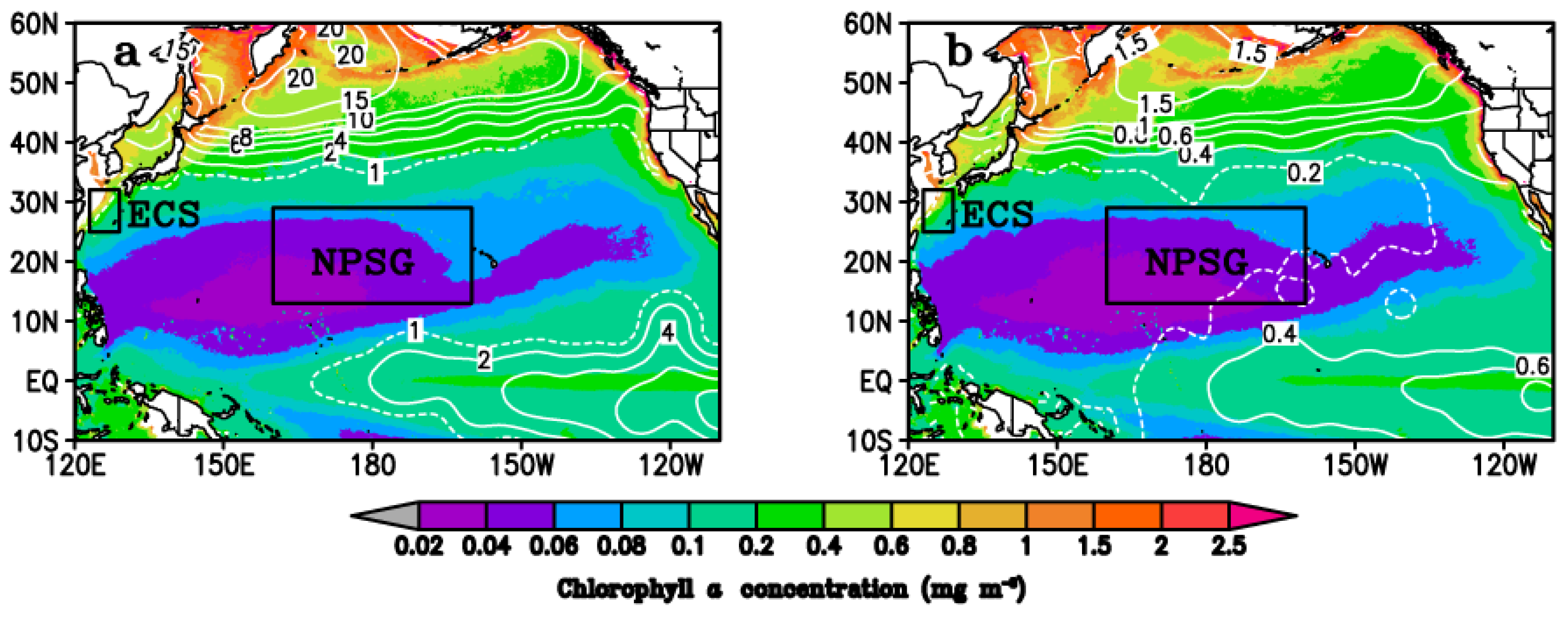
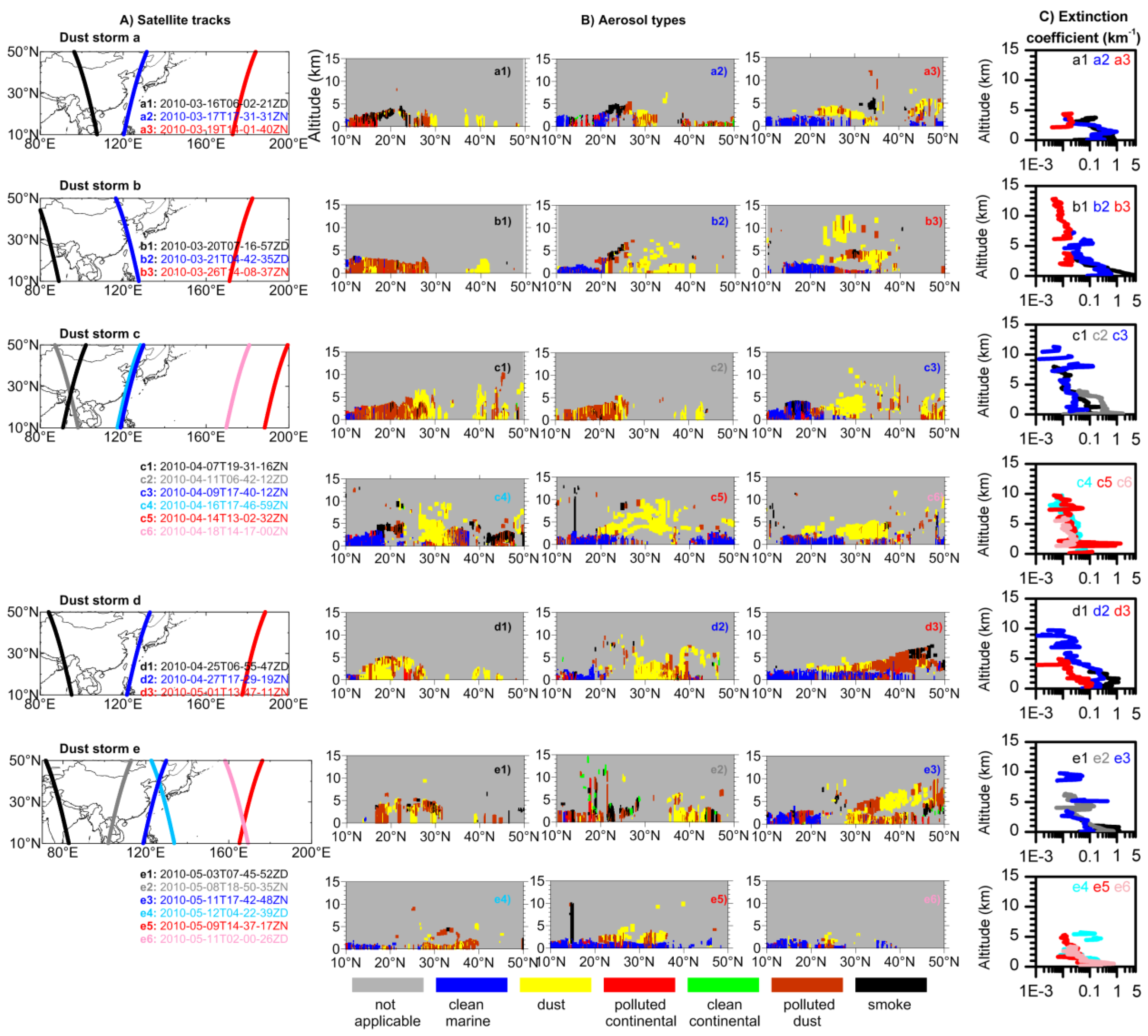
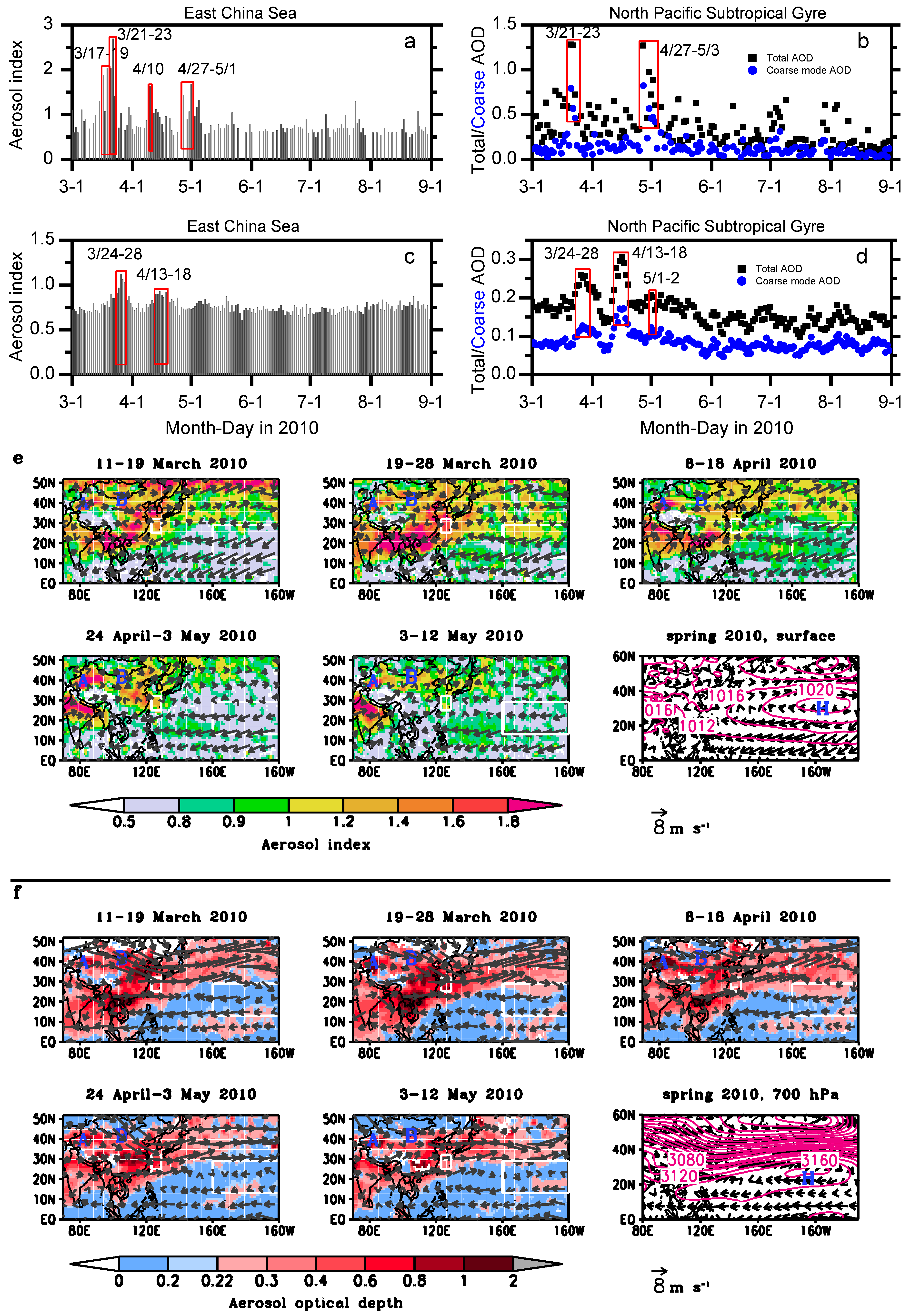
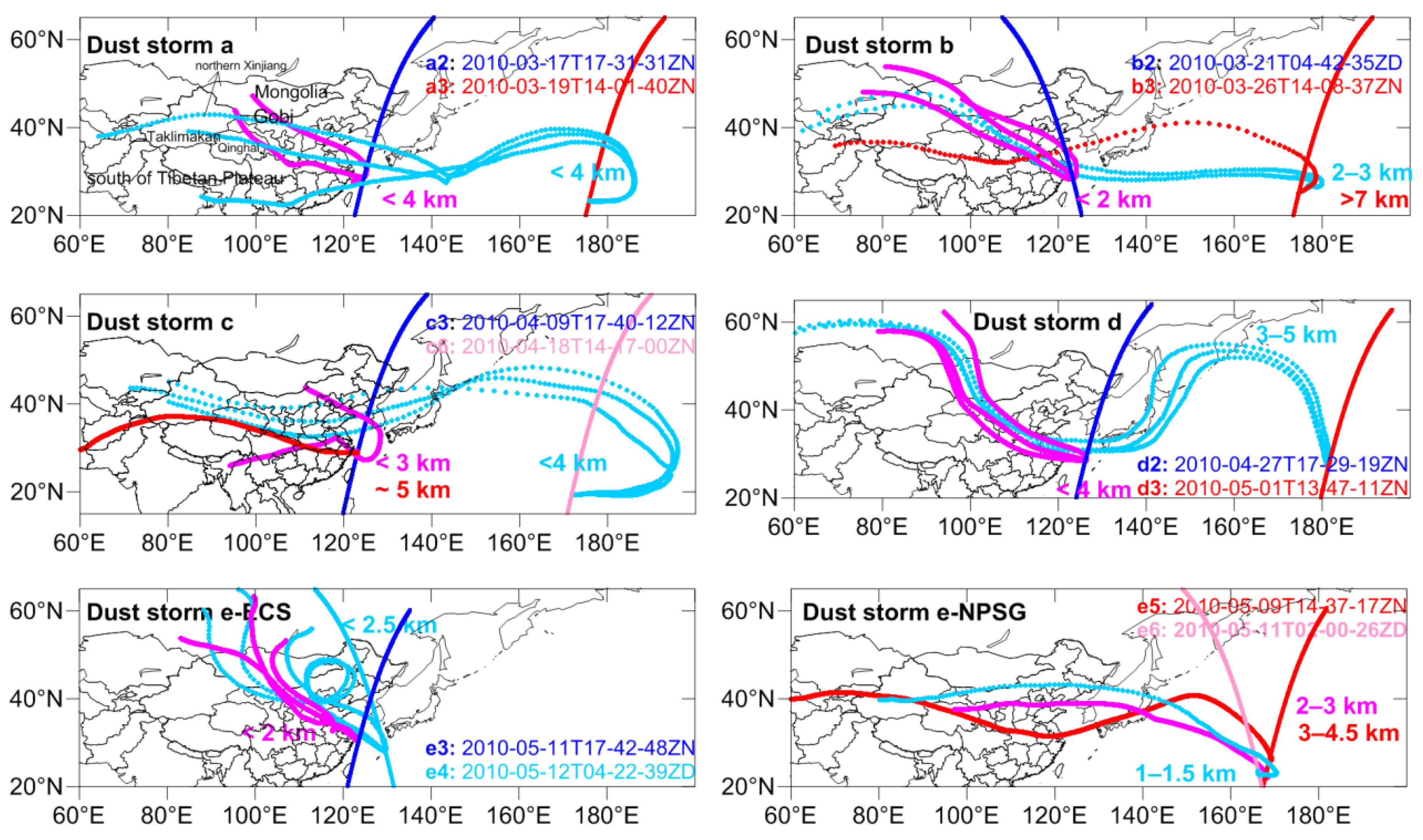

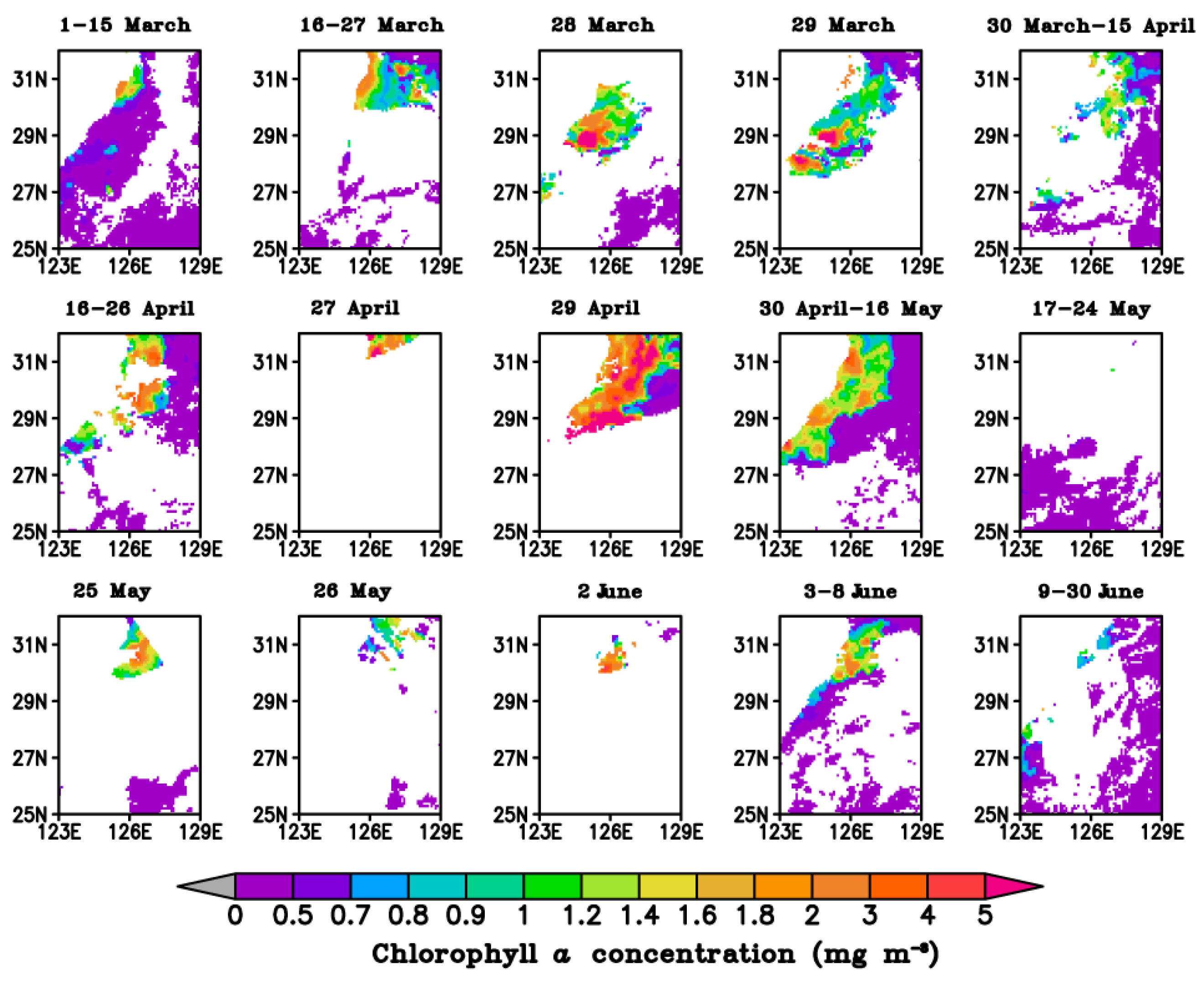
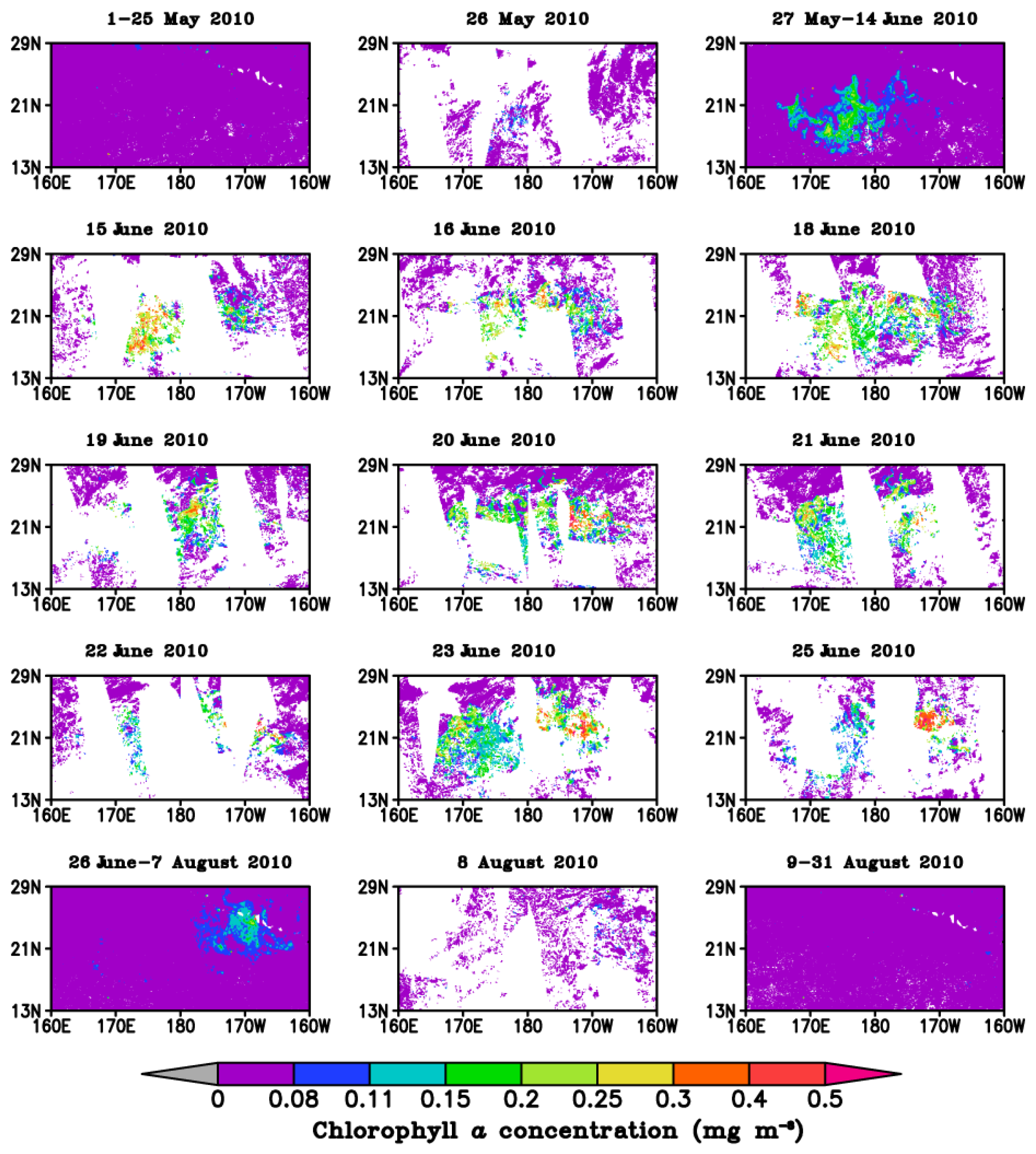
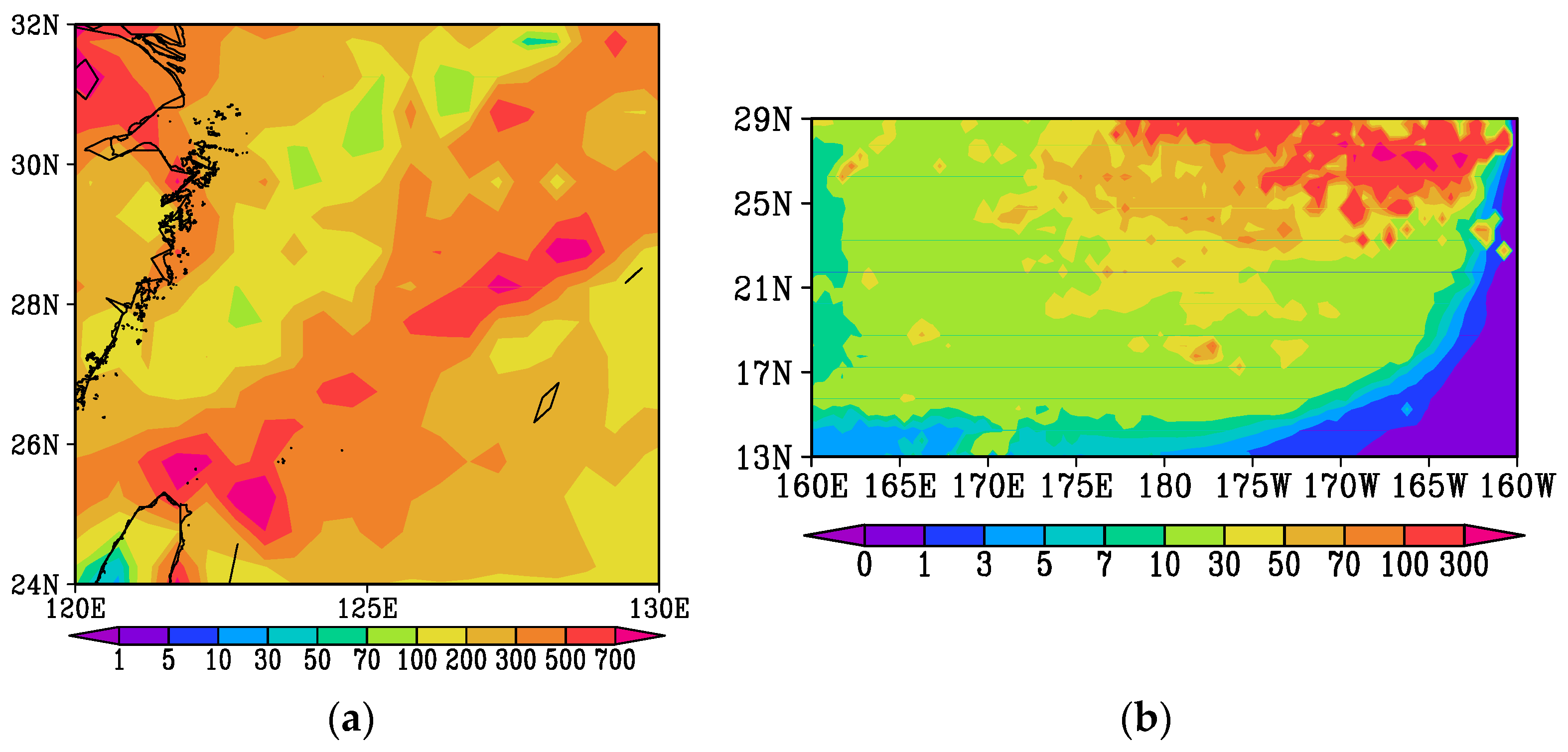
| Site | Observed PM10 Concentration (μg·m−3) | Modeled PM10 Concentration (μg·m−3) | Correlation Coefficient (R) |
|---|---|---|---|
| Hohhot | 102.7 | 152.8 | 0.85 |
| Urumqi | 127.0 | 41.7 | 0.57 |
| Lanzhou | 168.3 | 185.0 | 0.49 |
| Xi’an | 138.1 | 174.4 | 0.57 |
| Shanghai | 108.9 | 59.5 | 0.79 |
| Dust Storm [24] | Source Region | East China Sea | North Pacific Subtropical Gyre | |||||||
|---|---|---|---|---|---|---|---|---|---|---|
| CALIPSO Track | Mean Ext (km−1) | Altitude (km) | CALIPSO Track | Mean Ext (km−1) | Altitude (km) | CALIPSO Track | Mean Ext (km−1) | Altitude (km) | ||
| (a) | 11–12 March, dust storm 12–15 and 16–17 March, blowing dust storm | 2010-03-16T06-02-21ZD | 0.37 | 0.93 | 2010-03-17T17-31-31ZN | 0.20 | 0.72 | 2010-03-19T14-01-40ZN | 0.02 | 3.09 |
| (b) | 19–22 March, severe dust storm 21–23 March, dust storm | 2010-03-20T07-16-57ZD | 0.96 | 0.79 | 2010-03-21T04-42-35ZD | 0.15 | 1.09 | 2010-03-26T14-08-37ZN | 0.01 | 5.74 |
| (c) | 8, 9 and 11–12 April, blowing dust | 2010-04-07T19-31-16ZN | 0.05 | 3.18 | 2010-04-09T17-40-12ZN | 0.02 | 4.42 | 2010-04-14T13-02-32ZN | 0.02 | 4.13 |
| 2010-04-11T06-42-12ZD | 0.36 | 0.86 | 2010-04-16T17-46-59ZN | 0.03 | 3.11 | 2010-04-18T14-17-00ZN | 0.02 | 2.59 | ||
| (d) | 24–28 April, dust storm | 2010-04-25T06-55-47ZD | 0.53 | 0.92 | 2010-04-27T17-29-19ZN | 0.18 | 1.32 | 2010-05-01T13-47-11ZN | 0.02 | 2.54 |
| (e) | 3–4 and 8 May, blowing dust | 2010-05-03T07-45-52ZD | 0.33 | 0.49 | 2010-05-11T17-42-48ZN | 0.06 | 2.16 | 2010-05-09T14-37-17ZN | 0.02 | 2.69 |
| 2010-05-08T18-50-35ZN | 0.16 | 0.87 | 2010-05-12T04-22-39ZD | 0.14 | 3.42 | 2010-05-11T02-00-26ZD | 0.06 | 0.79 | ||
| Mean | 0.39 | 1.15 | Mean | 0.11 | 2.32 | Mean | 0.02 | 3.08 | ||
| Sea Regions | East China Sea | North Pacific Subtropical Gyre | |||
|---|---|---|---|---|---|
| Parameter | Nutrient Concentration | (Chl) (%) | New Production (%) | Nutrient Concentration | (Chl) (%) |
| Soluble iron (μg·m−2·d−1) | 7.5–84.3 (37.5) | 5–115 (56) | 20–227 (101) | 1.1–9.6 (5.0) | 19–291 (132) |
| Total inorganic nitrogen (mg·m−2·d−1) | 0.1–1.5 (0.6) | 0.1–2.0 (1.0) | 0.4–4.0 (1.8) | 0.006–0.06 (0.03) | 0.1–1.7 (0.8) |
| Soluble phosphorus (μg·m−2·d−1) | 2.1–23.2 (10.3) | 0.01–0.2 (0.1) | 0.04–0.5 (0.2) | 0.1–0.9 (0.5) | 0.01–0.2 (0.1) |
© 2016 by the authors; licensee MDPI, Basel, Switzerland. This article is an open access article distributed under the terms and conditions of the Creative Commons Attribution (CC-BY) license (http://creativecommons.org/licenses/by/4.0/).
Share and Cite
Tan, S.; Li, J.; Gao, H.; Wang, H.; Che, H.; Chen, B. Satellite-Observed Transport of Dust to the East China Sea and the North Pacific Subtropical Gyre: Contribution of Dust to the Increase in Chlorophyll during Spring 2010. Atmosphere 2016, 7, 152. https://doi.org/10.3390/atmos7110152
Tan S, Li J, Gao H, Wang H, Che H, Chen B. Satellite-Observed Transport of Dust to the East China Sea and the North Pacific Subtropical Gyre: Contribution of Dust to the Increase in Chlorophyll during Spring 2010. Atmosphere. 2016; 7(11):152. https://doi.org/10.3390/atmos7110152
Chicago/Turabian StyleTan, Saichun, Jiawei Li, Huiwang Gao, Hong Wang, Huizheng Che, and Bin Chen. 2016. "Satellite-Observed Transport of Dust to the East China Sea and the North Pacific Subtropical Gyre: Contribution of Dust to the Increase in Chlorophyll during Spring 2010" Atmosphere 7, no. 11: 152. https://doi.org/10.3390/atmos7110152






